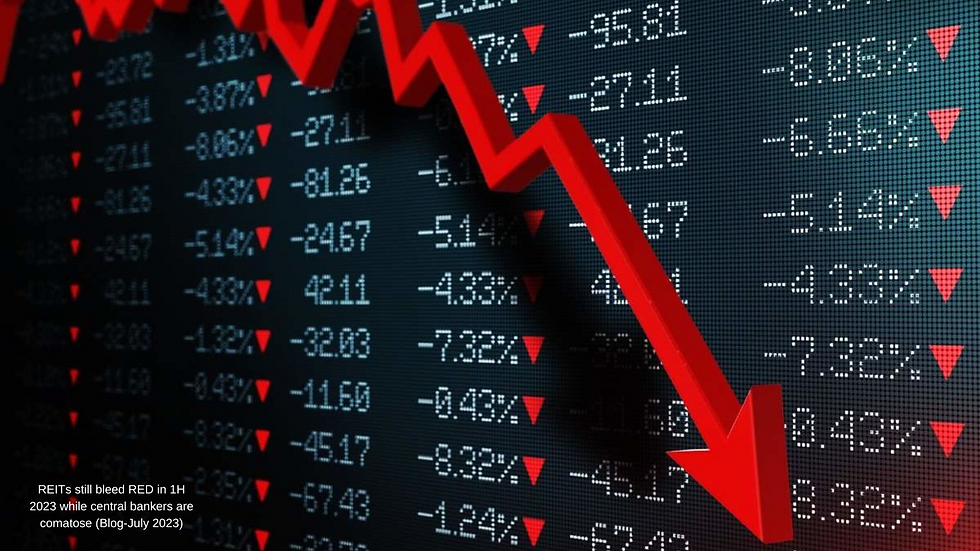THE INCONVENIENT TRUFT
- by Gabriel Yap

- Nov 18, 2017
- 3 min read
10/2013-
The Federal Reserve Chairman, Ben Bernake reminded investors on 22nd May 2013 of an inconvenient truft – the capital market party fuelled by cheap money cannot continue and will come to an end soon. The Fed’s US$85 billion a-month bond purchases would soon be reduced. Lo and behold, his words echoed across global financial markets, but nowhere as loudly as in emerging markets.

The subsequent sell-off in stocks, bonds, commodities and currencies have been sharp and indiscriminate – the top performing emerging markets (EM) like Thailand, Philippines and Indonesia have been literally spanked – they came off by 20% or more. The Japanese Nikkei was equally “chawamushi_ed” as it fell by almost 23%!
Emerging market currencies were not spared – the Turkish currency and Indian rupee slid to record lows and their Central banks were forced to intervene to stem the sharp currency declines.
Indeed such has been the strength of the preliminary review of what will happen when the capital markets have to adjust to higher interest rates, more likely in 2014. The warning bell has indeed been sounded.
The world’s capital markets have become addicted to cheap money and the recent episode of turbulence could be a harbinger of deeper turmoil when QE finally ends.
If so, will it prove a temporary spell of turmoil – painful but fleeting or will it herald more testing period for emerging markets with echoes of the crisis-riddled 1997 and 2007?
To me, I think it would be more the former – EM markets are certainly in a stronger footing now to deal with any fallout from any changes in US monetary policies. During previous crisis, many EM had pegged their exchange rates, had low foreign reserves, had rigid economies and bigh US$-denominated debt burdens. These vulnerabilities have mostly been addressed.
Thus, I really doubt if EM will go down the death spirals of 1997 although when the time comes when the inconvenient truft becomes altruism, EM may go down and economies will slow. Indeed, EM are also far less indebted that developed countries as the Financial Crisis of 2007 have illustrated. The overall credit-to-GDP is approximately 70% compared to a horrendous 145% for developed markets, according to the IMF.
Moreover, GDP is forecast to grow at 5% annually for the next 5 years for EM which would strengthen their foreign currency reserves further.
In my reckoning, most pension funds and insurers should be have diversified into EM long time ago. I applaud the foresight of the Norwegian sovereign wealth fund (SWF) which manages US$700 billion which changed its bond index to incorporate a higher weightage for EM. This was a catalyst for a few other SWF to follow suit.
Blackstone has correctly pointed out that each additional percentage point in portfolio exposure would funnel US$485 billion into EM. The current exposure is about 4%.
Of course not all EM are tainted from the same brush. The recent selloff was a good indication of where the weaklings are. In addition to India and Turkey, the Brazilian Real and South African Rand were equally sold off heavily. A common trait is that all 4 countries have big current account deficits and are largely commodity-dependent countries. The dangers are indeed magnified for those where international investments have fuelled domestic credit and capital market booms.
I will also cast my eyes on those EM which rely heavily on foreign investors to finance their country’s budget deficits – Hungary, Indonesia, Mexico and Poland come to mind. The risks lie in sudden spike in local bond yields when the crunch comes.
So how else will the inconvenient truft hit home?
Like what Warren Buffet has said – a rising tide lifts all boats, including leaking ones like Turkey and India. However, when the tide subside, a strewd investor would not wanna be heavily exposed to the weaker EM.
However, opportunities abound in EM and after the recent correction, stronger EM like Thailand, Mexico and Philippines have resumed their uptrend. The smart investor should be one to know how to make hay when the sun shines and to hibernate when the moon dances with the stars.




Comments